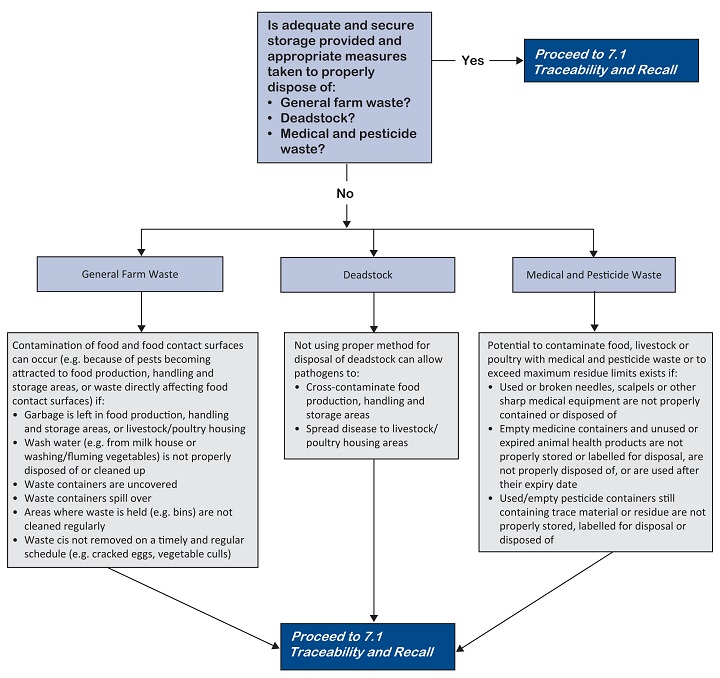Farm inputs - 6.4 Storage and disposal of farm wastes
If farm wastes, including deadstock, are not managed appropriately, they can cause contamination of the premises, livestock, inputs and food. The accumulation of farm waste can also provide habitats and food for pests.

This good agricultural practice applies to all farms.
Examples of different kinds of waste:
General farm waste is garbage and waste materials generated through normal production processes, including vegetable culls, cracked eggs and vegetable and barn wash water. Learn about the storage of manure and compost.
Medical waste is used medical equipment (for example, needles), unused or expired medicated feed, animal health products, packaging and/or containers.
Pesticide waste is unwanted pesticides and/or containers.
Deadstock waste are all on-farm livestock mortalities.
What needs to be done
Always store and dispose of farm waste properly.
How to do it
General farm waste
Storage:
- Locate farm waste storage areas away from food handling, input storage and livestock housing areas to prevent cross-contamination and avoid attracting pests
- Make sure farm waste storage areas and containers are adequate for the amount of waste generated between disposal/emptying times
- Clean farm waste storage areas often to avoid creating conditions that can cause cross-contamination or attract pests
- Where possible, use containers with lids for the storage of farm waste until it is removed
Disposal:
- Remove farm waste often and in a way that prevents cross-contamination and avoids attracting pests
- Dispose of all materials according to local municipal by-laws and provincial regulations
- If farm waste can be used by other sectors, store and ship in way that will not to pose a food safety hazard. Unless properly sanitized, vehicles used for transporting farm waste should not be used to transport food products and farm inputs.
Note: Crops grown on-farm can be fed to livestock housed on the same farm. Be sure to follow pesticide label instructions regarding grazing and feeding crops to livestock.
Medical waste
Storage
Store used needles, empty medicine containers and unwanted or expired animal health products in rigid, leak-proof containers labelled NON-HAZARDOUS WASTE (medicine bottles), or BIOMEDICAL WASTE (needles, scalpels and other “sharp” equipment).
Disposal:
- Follow suppliers’ or manufacturers’ instructions for disposal of syringes, medications and other items and outdated medical supplies
- Another possible disposal option may be your veterinarian. Disposal on your property or in burn barrels are not desirable disposal options
- Contact the Ministry of Environment at 1-800-663-3456 when disposal quantities are more than 5 kg or 5 litres
- Make sure medicated feed and water are disposed in a way that does not contaminate the environment
Used pesticide containers
Storage
Triple-rinse all empty pesticide containers by following these steps:
- Fill empty containers with water to a minimum of one-tenth of the container size.
- Rinse by recapping the container and shaking or rolling.
- Empty pesticide container contents into sprayer tank.
- Repeat steps 1 to 3 two times.
Do not reuse pesticide containers for storage of other items.
Disposal
Take rinsed containers to a pesticide container collection site for recycling.
There are four options to dispose of unwanted pesticides:
- Return unopened pesticide container to the dealer before winter.
- Apply pesticide to another crop specified on the label.
- Pay a hazardous waste disposal company to dispose of the pesticide.
- Participate in a pesticide return. Occasionally the government, pesticide industry and BC Agricultural Council coordinate special unwanted pesticide collection programs: Read about pestice return, proper disposal of used pesticide containers and unwanted pesticides (see second page)
Deadstock
Storage
Remove, compost or bury all regulated dead animals according to provincial regulations. Locate deadstock burial pit and composting site away from:
- Animal housing
- Fruit or vegetable production areas
- Areas of high livestock or human traffic
- Any sources of water
- Protect all stored deadstock from other livestock, poultry and predators and away from public view.
Disposal
Choose a method of regulated dead animal disposal that is currently approved in B.C. These include:
- Pick up by a provincially licensed deadstock pick-up service
- Composting at least 15 m from any watercourse and 30 m from any source of water used for domestic purposes
- Burial at least 30 m from any source of water used for domestic purposes and pits constructed to prevent pollution
If you need an audit
Be prepared for the auditor to observe or inquire about storage activities to ensure that:
- Adequate and proper waste storage areas and/or containers are clearly designated on the farm
- Farm waste storage containers and areas are well kept and maintained
- Farm waste is removed regularly
- Medical waste containers are clearly marked
- Empty pesticide containers and unwanted pesticides are stored in a designated area labelled for disposal
- Deadstock is stored and/or disposed of according to provincial regulations
Laws and regulations
The Code of Agricultural Practice for Waste Management under the Agricultural Waste Control Regulation, Reg. 131/92 sets out some of the requirements listed on this page. It also provides the rules around the management of manure, in certain circumstances. Check local municipal bylaws, which may also have legal requirements related to manure storage.
See the Hazardous Waste Regulation, Reg. 63/88, s. 50 under the Environmental Management Act and Transportation of Dangerous Goods Act (Canada), 1992 for requirements for storage, transportation and disposal of pesticides, biohazards or infection substances.
The Integrated Pest Management Act, S.B.C. 2003, c. 58, Integrated Pest Management Regulation, Reg. 604/04, s. 33 also requires proper disposal of pesticides and their containers.
